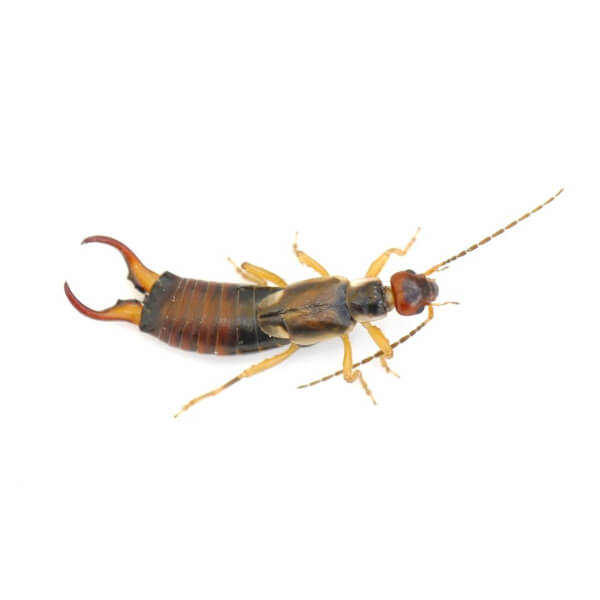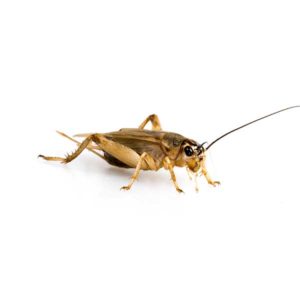Earwigs in North Carolina
Earwigs owe their name to the superstition that they purposely crawl into the ears of sleeping people and bore into the brain. Even though earwigs prefer moist, dark places, they choose these places for daytime hiding, not at night when people are sleeping. Earwigs are mostly nocturnal, searching for and feeding on a wide variety of insects and plants after dark. They are more common in the southern and southwestern United States and tend to hibernate during the winter months. Earwigs may seek refuge in homes when conditions outside are too dry, hot, or cold.
Because there are many different types of beetles in North Carolina, they can be difficult to distinguish, however our common beetle species can help with this.
Earwig Habitat
The diet of earwigs consists of a wide variety of plant and animal matter. Earwigs feed on leaves, flowers, fruits, and fungi, as well as on aphids and larger insects such as flies, captured with their pincer-like cerci. Day-time hiding places include under logs, rocks, boards, or dense growth of vines or weeds. Around homes, they can be found in moisture-rich environments such as cracks near swimming pool areas, flower bed mulch, underneath outdoor potted plants, and leaf litter. Inside homes, they will congregate in flaps of cardboard boxes and inside kitchens and bathrooms.
Earwig Behaviors, Threats, or Dangers
In gardens, earwigs can chew irregular holes in leaves and flower blossoms. Earwigs can enter homes through gaps and cracks of siding and foundations. They can also gain access when homeowners transfer items like potted plants, firewood, or cardboard boxes from outside to inside the home.
If you are dealing with excess earwigs on your property, contact a local pest control professional.
Signs of an Earwig Infestation
Identifying an earwig infestation involves recognizing both the insects themselves and the signs of their presence. Key indicators include:
- Visible earwigs, especially in moist environments.
- Damage to plant leaves, characterized by irregular holes and chew marks.
- Accumulation of earwigs under pots, stones, and organic debris.
Earwig Bites
Earwigs don’t bite people or spread disease, but they can pinch. Although their pincers are not likely to break the skin, a pinch from an earwig can hurt. For the most part, earwigs are considered a nuisance pest during spring and summer. While earwigs can use their pincers to pinch if handled or threatened, they do not bite humans and are not venomous. Any discomfort from a pinch is temporary and without lasting effects.
Are Earwigs Dangerous?
Contrary to some myths, earwigs do not pose a danger to humans. They do not crawl into ears or spread diseases. The primary concern with earwigs is the potential damage to garden plants and unwelcome entry into homes.
How to Get Rid of Earwigs?
Managing an earwig population involves a combination of immediate actions and long-term strategies:
- Immediate Removal: Collect and remove earwigs from indoor areas manually, using gloves to prevent pinching.
- Reduce Moisture: Employ dehumidifiers and ensure proper ventilation in prone areas to make them less attractive to earwigs.
- Physical Barriers: Seal cracks and openings around the home’s foundation to deter entry.
Long-Term Control
- Garden Maintenance: Regularly clear away debris and excess mulch to minimize earwig hiding spots.
- Diatomaceous Earth: Apply this natural powder around the home’s perimeter and garden areas to deter earwigs.
- Encourage Predators: Birds and toads are natural predators of earwigs and can help control their population.
Earwig Prevention Tips
Prevention focuses on creating an environment less conducive to earwigs:
- Moisture Control: Keep gardens well-drained and avoid overwatering.
- Storage Practices: Store firewood and other materials away from the house to reduce harborage opportunities.
- Regular Cleaning: Vacuum and clean basements and crawl spaces regularly to remove earwigs and their eggs.
Need help with Earwigs control?
Frequently Asked Questions
Should You Kill Earwigs?
While killing earwigs is not always necessary, managing their population can prevent damage to plants and reduce their presence indoors. Natural and physical control methods are often sufficient.
What Are the Problems with Earwigs?
The primary concerns with earwigs are their potential to damage garden plants and their unwanted presence in homes. They are, however, beneficial to the ecosystem, helping break down decaying matter.





